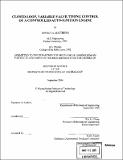| dc.contributor.advisor | Wai K. Cheng. | en_US |
| dc.contributor.author | Matthews, Jeffrey A., 1970- | en_US |
| dc.contributor.other | Massachusetts Institute of Technology. Dept. of Mechanical Engineering. | en_US |
| dc.date.accessioned | 2006-03-24T18:40:13Z | |
| dc.date.available | 2006-03-24T18:40:13Z | |
| dc.date.issued | 2004 | en_US |
| dc.identifier.uri | http://hdl.handle.net/1721.1/30324 | |
| dc.description | Thesis (Sc. D.)--Massachusetts Institute of Technology, Dept. of Mechanical Engineering, 2004. | en_US |
| dc.description | "September 2004." | en_US |
| dc.description | Includes bibliographical references (p. 123-124). | en_US |
| dc.description.abstract | The objective of this study was to develop a closed-loop controller for use on a Controlled-Auto- Ignition (CAI) / Spark-Ignition (SI) mixed mode engine equipped with a variable-valve-timing (VVT) mechanism. The controller in this study was designed only for use in the CAI regime. Operation in the SI regime and control of transitions between the CAI and SI modes were considered to be outside the scope of this study. The first part of the study involved creating an open-loop feedforward controller. This controller transformed desired engine output into required input based on a mapping of the steady-state output-to-input transfer function at constant engine speed and intake manifold temperature. Since the mapping domain was limited, the open-loop controller did not compensate for changes in operating conditions. This controller was used to study the transient response of the engine. Using the transient data, a mathematical representation of the engine output; i.e. mean effective pressure (MEP) and fuel-air equivalence ratio (), its in-cylinder state; i.e. mass of fuel, mass of air, percent mass exhaust gas residual and pressure, and input to the engine; i.e. mass of fuel, intake valve closing and exhaust valve closing, was developed. This representation showed that the CAI engine is effectively a quasi-static system in that the output of any given cycle depends almost entirely on the in-cylinder state at the start of that cycle, and that the latter depends almost entirely on prior cycle input. The quasi-static nature of the CAI engine effectively defined the architecture of the closed-loop controller; namely, a feedforward and feedback sub-controllers. A numerical model of the CAI engine and a closed-loop control system were developed. | en_US |
| dc.description.abstract | (cont.) A comparison of output from the model and engine showed excellent correlation. The model was then used to determine the gains of the closed-loop controller. Validation of the closed-loop controller consisted of comparing output from the CAI engine subject to closed-loop control to both the desired output and output from the engine subject to open-loop control. Visual cycle- by-cycle and statistical comparisons showed that the performance of the CAI engine improved significantly when subject to closed-loop control. This was especially true when the environmental and operating parameters not included in the original feedforward mapping; i.e. engine speed and intake manifold temperature, were allowed to vary. | en_US |
| dc.description.statementofresponsibility | by Jeffrey A. Matthews. | en_US |
| dc.format.extent | 125 p. | en_US |
| dc.format.extent | 6414631 bytes | |
| dc.format.extent | 6430385 bytes | |
| dc.format.mimetype | application/pdf | |
| dc.format.mimetype | application/pdf | |
| dc.language.iso | eng | en_US |
| dc.publisher | Massachusetts Institute of Technology | en_US |
| dc.rights | M.I.T. theses are protected by copyright. They may be viewed from this source for any purpose, but reproduction or distribution in any format is prohibited without written permission. See provided URL for inquiries about permission. | en_US |
| dc.rights.uri | http://dspace.mit.edu/handle/1721.1/7582 | |
| dc.subject | Mechanical Engineering. | en_US |
| dc.title | Closed-loop, variable-valve-timing control of a controlled-auto-ignition engine | en_US |
| dc.type | Thesis | en_US |
| dc.description.degree | Sc.D. | en_US |
| dc.contributor.department | Massachusetts Institute of Technology. Department of Mechanical Engineering | |
| dc.identifier.oclc | 61103821 | en_US |
